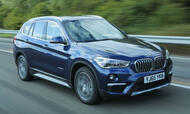
Does BMW's second-generation crossover make for a better used buy than rivals from Audi, Mercedes and Land Rover?
The original BMW X1 racked up more than 700,000 global sales between 2009 and 2015, but for all its success it was plainly styled, poorly packaged and flawed on the road.Happily, the Mk2 car of 2015 to 2022 fixed all of that, and it holds up today as a great-value family hauler with up-to-date technology and real kerb appeal.Prices start at about £5000 for cars with more than 100,000 miles under their wheels, but with a budget of around £8500 you can easily find a clean and well-equipped example that will have the neighbours’ curtains twitching.You might think it a relatively staid, front-driven family SUV, but the X1 is a surprisingly good car to drive, cleverly hiding the extra bulk and height it has over a normal family hatchback.Its steering is precise and communicative, it maintains good body control and it generally inspires confidence when you thread it down a rural road. Sure, it’s not as engaging as some of BMW’s rear-driven offerings, but it’s pleasant nonetheless and reasonably comfortable.If you’re after a bit more ride quality, look for the optional adaptive dampers, which add an extra layer of comfort. The alternative is to go for an entry-level SE car with the smallest (17in) wheels and comfort suspension.And even SE trim is well equipped, with BMW’s iDrive infotainment system, a powered tailgate and rear parking sensors all included.A tidy 60,000-miler will cost about £10,000. You will need at least £2000 more for a car in M Sport trim, with its bodykit and firmer suspension. Sport and xLine trims offer the best value for money. The latter adds leather seats and LED headlights, and looks classy with its chrome exterior trim.That said, all versions feel solid and refined inside: the plastics on the doors and by your feet are solid, while the aluminium brightwork on the dash exudes an upmarket feel. You sit nice and high in the front and there’s plenty of head and leg room in the back, too.Make sure you find a car fitted with a sliding rear bench: it adds an extra layer of flexibility to the cabin and allows you to increase the boot capacity should you need it. That said, the 505-litre boot is good for its class and is large enough for a buggy, golf clubs or a few suitcases.There’s a good mix of 2.0-litre turbocharged four-cylinder engines to choose from. The front-wheel-drive sDrive18d diesel is ideal for daily duties, and you can expect around 50mpg.You can get the same oil-burner with four-wheel drive should you need the extra pulling power, but for towing a caravan or trailer we would opt for the 187bhp xDrive20d.It has a bit more poke yet is just as efficient. Some will be drawn to the 228bhp xDrive25d: while it’s a bit firm-riding, it blends impressive performance with decent economy.There’s also the 1.5-litre three-cylinder sDrive18i petrol engine borrowed from the Mini hatchback. It’s by no means quick, but you will easily get 40-45mpg out of it. Petrol options are that 138bhp sDrive18i or the sprightly 189bhp 20i, which can be had in front- or four-wheel-drive form.A mild facelift in 2019 brought tweaks to the exterior and interior, while the 217bhp plug-in hybrid xDrive25e with an electric-only range of 35 miles joined the line-up. PHEVs are a bit dearer than regular petrols and diesels, but whichever engine or trim you go for, a Mk2 X1 is money well spent.

